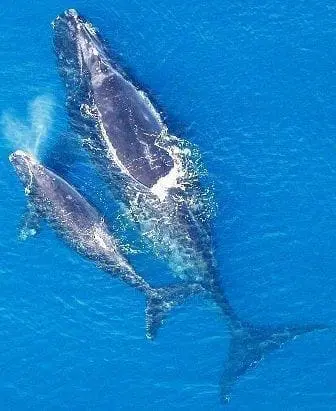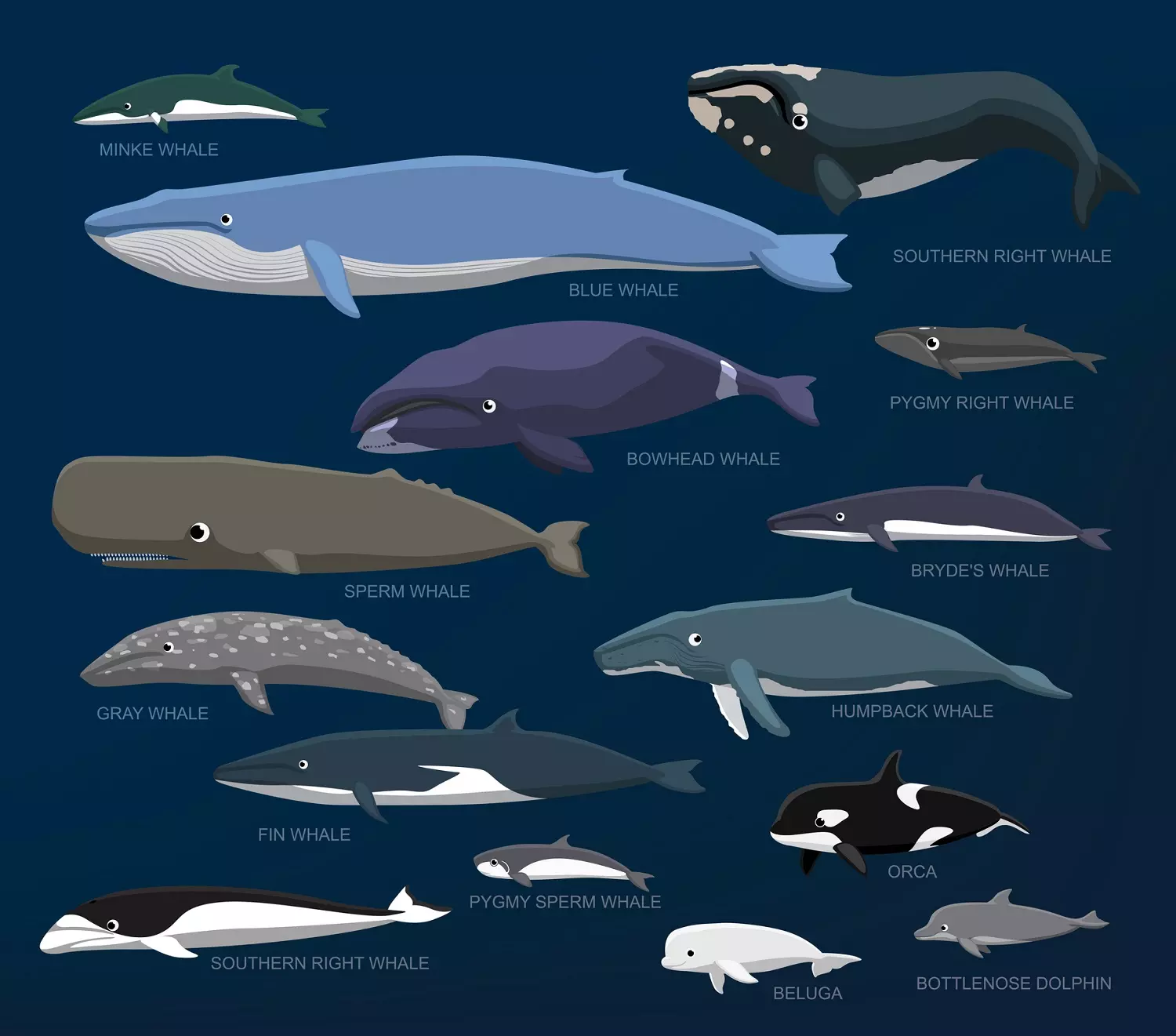Illustration comparing whale species sizes, cartoon eyes added
[Originally published as part of God’s Amazing Creatures]
Did you know that the largest animal that ever lived is the Blue Whale and the body weight of that amazing mammal is many times heavier than the largest dinosaur ever discovered?
Originally, Charles Darwin believed that whales might have evolved from bears.
In North America the black bear was seen by Hearne (observers) swimming for hours with widely open mouth, thus catching, like a whale, insects in the water. Even in so extreme a case as this, if the supply of insects were constant, and if better adapted competitors did not already exist in the country, I can see no difficulty in a race of bears being rendered, by natural selection, more and more aquatic in their structure and habits, with larger and larger mouths, till a creature was produced as monstrous as a whale.—Charles Darwin, The Origin of Species (1859 and 1984 editions), p. 184.
There are hundreds of ‘just so’ stories that pass for evidence of evolutionary theory. In fact, today evolutionary scientists think that whales are related to cows. The renowned educator David Berlinski who received his Ph.D. in philosophy from Princeton University and later became a Fellow of the Faculty in Mathematics and a Post Doctoral Fellow in molecular biology at Columbia University said this with regard to the ‘just so’ story of whale evolution,
“The stories quickly change from plausible to ridiculous. I liken the cow to whale evolution to the engineering task of converting a car to a submarine. Why are the 50,000+ required morphological changes not found in the fossil record?”
While the cow to whale evolutionary scenario is clearly fantasy, whales are truly amazing creatures. God created them and designed them with some very special characteristics. Here is a short list of those astounding characteristics.
- Whales can eat while moving at 16 mph, travel long distances at a top speed of 30mph.
- Some whales carry out annual migrations of 16,000 miles.
- Whales can compose complicated musical pieces that serve as a form of underwater language.
- There are whales that can blow a spout of water 50 feet into the air with just one exhale.
- Sperm whales hold the deep sea diving world record at approximately 10,000 feet below the surface.
- Some whales have a lung volume of 793 gallons (3,000 liters). Humans have a lung capacity of just over one gallon (4 liters), or at most, 1.8 gallons or 7 liters.
- Whales produce the world’s richest milk with a world record butter-fat content of 42%. Human milk by comparison has a butter-fat content of 4.4%.
- Some whales have tongues so heavy that they weigh as much as two fully grown horses.
- There are whales with aortas of 20 inches in diameter. That is the size of an average water main.
The Blue Whale is the largest creature that has ever been found. The body weight of this amazing mammal is many times heavier than the largest dinosaur ever discovered.
In general, the sizes of whale calves are enormous at birth. The largest land mammal, the African elephant male is only 4,400 pounds fully grown.
Greenland whales Calf = 20 feet and 6 tons at birth
Northern Right whale = 16.4 feet and 56 tons at birth
Humpback whale = 15 feet and 2.5 tons at birth
Grey whale = 15 feet and 1.5 tons at birth
The Blue whale generates 1,175 horsepower which requires 20,000 liter of oxygen to cruise at 17.3 mph. The whale fluke or tail is designed horizontally because in terms of fluid dynamics it is much more practical for constant diving and surfacing than a vertical fluke would be.
Whales are intentionally created to be streamlined and even their skin is designed to reduce water turbulence streaming over our bodies, and transform it into laminar flow with reduced resistance. This captures a portion of the turbulent energy of the water, and achieves a damping effect of the vortices near the surface of our skin over their entire body.
The bodies of whales are designed to endure the enormous pressures o deep sea diving. At 3,280 feet below sea level, it would be the same as having the boxing heavyweight champion of the world standing on your fingernail. That would mean the volume of eleven football field lengths of water would be above us. The pressure is 1421 pounds per square inch (almost 100 atmospheres). 200,000 pounds (100 tons) of water press on every square foot of the whale.
The Creator has equipped these deep sea diving mammals with a special conservation system. During a dive their heart rate is cut in half. The non-essential regions of their body are shut off from the circulatory system. The blood supply is re-directed to their most important organs, the heart, the brain and their tale structures.
Deep sea diving mammals like dolphins and whales can hold their breath for up to 1 ½ hours. This prevents them from getting the bends when they come back up to the surface to breath. The bends is just like opening a champagne bottle without letting the pressure equalize. The champagne seems to explode out the top of the bottle. If this happens inside a person, or any deep sea diving mammal, it can cause deadly blockages, embolisms and clots. To inhibit this from happening, a diver must surface gradually or be placed in special decompression chamber.
The lungs of mammals are incredibly delicate organs, however, the internal organs of whales are designed to survive the immense pressures that deep sea diving brings to bear. Without special design features whale lungs should just fall in on themselves like a wet sack and collapse. Land mammals have a windpipe and large bronchial tubes that are equipped with supporting rings, so they are able to remain open while inhaling. Just like the rings on a vacuum cleaner hose, a whale’s bronchial tube is re-enforced to withstand enormous pressures.
A whaler once documented 28,000 small squid in the belly of a Sperm whale, but the all time favorite food of this species is the giant squid. Such whales are designed to find their food in the lower regions of the ocean where there is little or no light at all. Instead they use a sophisticated type of sonar called echolocation to locate their prey.
The whale’s nose is placed on the top of their heads to enable them to breath easily while swimming. Marine mammals have been given a highly sophisticated stereo seismographic hearing apparatus. For decades evolutionary scientists thought that whales were deaf. Even after hints of a complicated inner ear and highly specialized auditory nerves were discovered, they were chalked up to being the evolutionary remnants from some hypothetical ancestor.
Whales are grouped into two different types. The toothed whales and baleen whales. Baleen whales do not have teeth. They have baleen in their upper jaw that acts like a filter mesh or comb. They squeeze mouthfuls of sea water out and the small sea creatures, especially krill and plankton, remain and are swallowed. The toothed whales are active hunters, feeding on fish, squid, and in some cases marine mammals. Sperm whales, pilot whales and Orcas (killer whales) are examples of this species.
Humpback whales are famous for their exceptional hunting methods. They swim in rising spirals around a swarm of krill, and expel a precisely measured stream of air through their nose. This forms a curtain of tiny air bubbles which acts like a net. The tiny micro-organisms flee from the air screen and gather in the center of the cylinder. The circle of air bubbles scarcely reaches the surface of the water before these whales swoop up through the center of it with open jaws. Before they swallow, excess water pours out of the sides of its mouth through the baleen. The prey remains stuck in the mesh of this great filtering apparatus. Using this method, the Humpback can filter its nourishment from the sea in 100 pound batches.








Thankful for resources like this one that share falsities in evolution and instead point to the Creator!
You’re welcome, Nikki! It is an honor and delight to share how the real world points to its real Creator, Jesus.